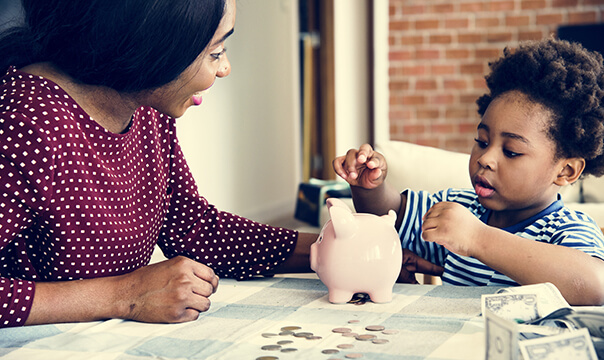
FDIC-Insured - Backed by the full faith and credit of the U.S. Government

Key takeaways
Failing can be a good learning tool. Letting your kids “fail” with money can teach them financial responsibility and independence.
With your supervision, managing an allowance, practice using a credit card and opening an investment account are low-risk opportunities to learn about money management.
Be sure to celebrate successes and reflect on failures to help enforce learnings.
One mindset that has driven success in Silicon Valley is the mantra “Fail often, fail fast, fail forward.” The idea is that failures can guide future efforts away from previous mistakes and towards success. In that sense, failure is a seen as a positive learning tool.
This same approach may be valuable when it comes to giving your children an opportunity to “fail” with money. For parents, seeing kids fail can be challenging. But letting them experience some financial mistakes in a low-risk situation can help them develop financial responsibility and independence.
“When parents swoop in and save their kids financially, they’re putting out a safety net. If there is no net, kids will figure things out faster to save themselves.”
Tom Thiegs, senior leadership and legacy consultant for Ascent Private Capital Management of U.S. Bank
“As parents, we might want to swoop in and save kids financially when they encounter money challenges, but this approach can have some unintended consequences – specifically in the form of a financial safety net,” says Tom Thiegs, senior leadership and legacy consultant for Ascent Private Capital Management of U.S. Bank. “If there is no net, kids will figure things out faster to better prepare themselves for future situations.”
How to structure failure: Three ways to help teach financial responsibility
Not all failure is helpful, of course. Reckless actions or disastrous mistakes are poor learning opportunities. For example, you wouldn’t want your children to wipe out their college fund simply to give them a lesson in managing money.
On the other hand, failure can be constructive when a person takes a calculated risk, falls short and gains skills and experience for the next attempt. “Constructive failure comes when you use the failure to propel yourself to greater things, and you truly take the lessons you learned to heart,” Thiegs says.
Relatively low-stakes financial experiences can give your children an opportunity to learn from failures without having to risk major financial losses. Here are three examples.
1. Provide a work-based allowance
Requiring children to work for their allowance teaches them money isn’t just given. While there are different ways to structure an allowance, Thiegs suggests paying children – usually starting around age 6 – for extra chores, not for their basic household responsibilities. He recommends establishing a system of “spend, share and save” with children, dividing their money into three separate funds.
To help children learn how to budget, parents may have to let kids make questionable spending decisions they wouldn’t choose themselves. “As kids get older, it’s important to teach them opportunity costs—if you buy this, then you can’t have that,” Thiegs says.
One experiment to help children practice managing money would be to pay them their allowance up front for one month. If they run out of money before the month ends, they might have to pass up on an activity with friends. “If they’re allowed to make those mistakes, they’re going to eventually incorporate some smarter analysis into the way they spend,” Thiegs says.
2. Practice using a credit card
“Children today will likely have minimal experience with paper cash in adulthood, so it’s important to get them used to dealing with non-cash transactions,” Thiegs suggests. Credit or debit cards are a good opportunity to learn how to budget and practice money management. Credit cards also come with real and negative consequences if not used properly.
Since you must be 18 to apply for a credit card, most teens can only apply for one jointly with an adult. Doing so means your credit is tied to their spending habits, making it even more important for you to emphasize good spending habits with your child.
To keep the potential for failure small, start with a low spending limit; this way, you can still give them some room for error. “It’s important that parents don’t hover too close, but regular check-ins on progress work well,” Thiegs recommends. Set out clear consequences for failure to pay and hold children accountable. Stress that credit cards should only be used for things that have already been saved for since using a credit card is essentially using borrowed funds.
“Mistakes with credit cards can be meaningful,” Thiegs says. “They can affect your credit score, which can affect getting a job or an apartment in the future.” Before children start using a credit card, explain that they will be responsible for interest charges or late fees. Then, stick to your plan.
Keep in mind that while you don’t want to establish a pattern of covering for your child if they make mistakes, you still need to ensure the card minimum is paid each month to protect credit.
Finally, review every credit card statement with your child. If they spent too much, how will they adjust? If your child forgot to pay the bill, what reminders could be set up for the next time?
3. Open a small investment account
As your high-school age child grows and becomes more comfortable managing money, another productive experiment can be to set up a small investment account to help them experience investing.* You can open and manage a custodial account on behalf of your child through the Uniform Gifts of Minors Act (UGMA) or the Uniform Transfers to Minors Act (UTMA). It then transfers to their name when they reach the age of 18 or older, depending on applicable state laws.
Children will learn how to research investment opportunities and determine whether a potential investment is a good value. “Parents should teach some initial lessons on investing and provide additional resources for learning,” Thiegs says. “But after that, try to stand back and let the kids execute on their decisions and experience the ups and downs.” These lessons with lower stakes can be helpful for their future decision-making.
Through this experiment, children will understand more about stocks, bonds, risk, and diversification. They can develop strategies for making informed and logical, rather than emotional, investment decisions.
Discuss financial lessons learned
Instead of avoiding constructive failure, celebrate it. Your child took a risk, and even if it wasn’t the best outcome, good things can come from the process. “You’re helping them envision and commit to a goal of learning about finances,” Thiegs says. “One of the greatest gifts you can give a child is that can-do attitude and the ability to pick themselves up and learn from the past.”
Reflect on the experiment with your child:
- What was the goal?
- What choices or mistakes led your child to achieve or fall short of that goal?
- What did your child learn that might be helpful next time?
- What skills might you work on together to improve the odds of success?
By designing controlled experiments and allowing your children to fail (within reason), you will better prepare them to accept financial responsibility as adults. Your children will be more informed, creative and resilient, confident that they have the skills to cope with uncertain situations. They’ll learn to transform failure into success.
*All investment strategies have the potential for profit or loss. Diversification and asset allocation do not guarantee returns or protect against losses.
Related articles

3 simple ways to teach your kids about money
Three ways you can help your children feel empowered to manage their money.

What should you do with extra cash?
Before you use it to treat yourself, consider the ways a cash surplus can help you improve your finances.
